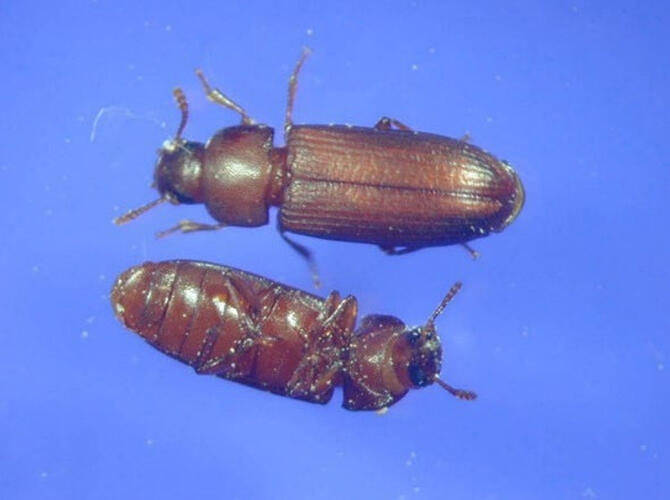A research group led by Graduate Student Motoya Ishikawa of the Graduate School of Environment, Life, Natural Science and Technology at Okayama University and Special-Appointment Assistant Professor Kentarou Matsumura and Professor Takahisa Miyatake of the Faculty of Environmental, Life, Natural Science and Technology at Okayama University has announced that they have discovered that the time taken for adult Tribolium castaneum (an insect pest of stored grains) to awaken from its 'death-feigning behavior' can be shortened by exposing it to the scent of the aggregation pheromone of the same species. The duration of death feigning was found using an artificially selected breeding line. The results were published in the September 13, 2023 issue of the Journal of Ethology, the official journal of the Japan Ethological Society.

Provided by Takahisa Miyatake, Okayama University
Death-feigning behavior, in which an animal becomes motionless in a unique posture when stimulated, is found in a wide variety of taxa, including mammals, birds, reptiles, amphibians, fish, mites, and insects. However, if the individuals pretend to be dead all the time, they may be attacked by predators and need to be awakened. Additionally, death feigning reduces their chances of encountering the opposite sex and finding food. The answer to 'when do they awaken?' was difficult to determine because there were large individual differences in the depth of sleep while they were death-feigning.
In 2019, the research group found that T. castaneum interrupts its death feigning and starts walking at a certain intensity of vibration and they continued to study the death-feigning behavior. In this study, they established a T. castaneum line in which the duration of death feigning was genetically fixed through the process of artificial selection. Using this line, experiments were conducted with artificially synthesized pheromone agents to determine how the presence of aggregation pheromones affected their awakening from death feigning.
Individuals exposed to the pheromone were awakened significantly earlier (40 min duration of death feigning) than those not exposed to the agent (60 min duration of death feigning). The time taken to detect the aggregation pheromone and awaken varied among individuals, suggesting that those that can detect the pheromone released by the male and awaken may have a survival advantage over those that cannot. If they can awaken, they have the advantages of being able to meet the opposite sex sooner, feed more quickly, and escape predators in situations where death feigning is ineffective.
Miyatake stated, "Since there are large variations in the duration of death feigning among individuals and their conditions, it was important to create a line with a uniform duration of death feigning for a long period of time through breeding. It took approximately 20 long years to produce this line. We believe that in some other insects, the stimulation by sex pheromones emitted from the opposite sex shortens the duration of death feigning. We think it will be necessary in the future to consider insect survival strategies from the perspective of which is more important; that is, the anti-predator strategy or the reproductive strategy (although both are important), depending on the situation."
Journal Information
Publication: Journal of Ethology
Title: Aggregation pheromone interrupts death feigning in the red flour beetle Tribolium castaneum
DOI: 10.1007/s10164-023-00793-2
This article has been translated by JST with permission from The Science News Ltd. (https://sci-news.co.jp/). Unauthorized reproduction of the article and photographs is prohibited.




